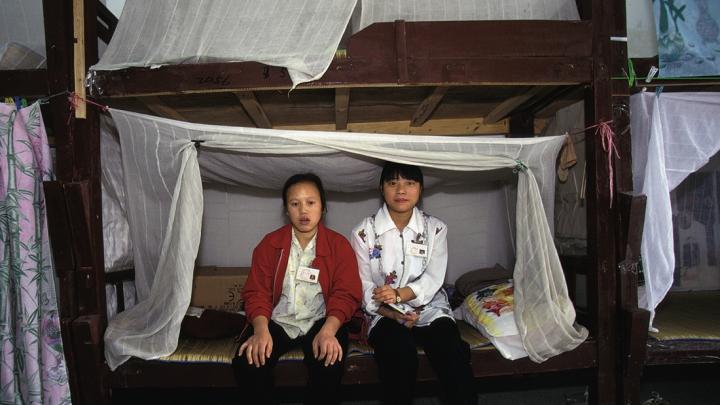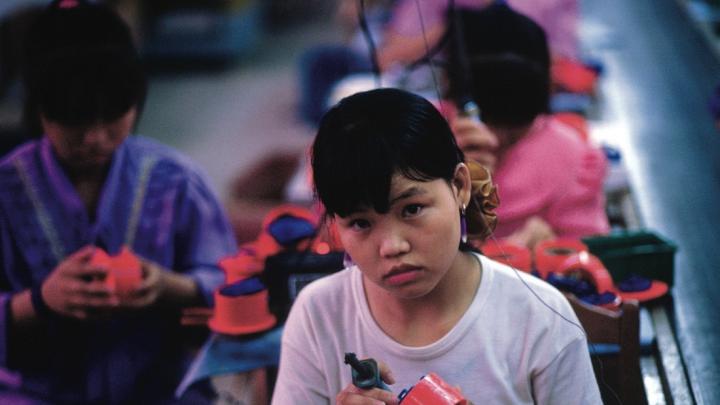The massive rural-to-urban labor migration that has been transforming China since the late 1980s—an estimated 130 million people—is unprecedented in that nation’s history. Unprompted by direct ecological or political factors such as famine, war, or the forced relocation of population groups under draconian state policy, migration in post-Mao China is more likely to be instead the result of structural forces (economic need and consequences of agricultural reform) that are beyond the control of individual farmers. Motivated by the search for opportunities to improve their own lives, rural people have taken the initiative, making decisions to shape their own destinies—and fostering unforeseen entrepreneurial individualism in the process. Above all, restless young village women have assumed a major role in the current population shift, establishing a brand-new identity as dagongmei (literally, “working sisters”) in the booming industrial cities in China’s coastal areas, contributing to what sociologists call the “feminization of the global workforce.”
In Factory Girls: From Village to City in a Changing China, Leslie T. Chang ’91, who spent a decade in China as a correspondent for the Wall Street Journal, delivers a vivid portrayal both of the dynamics of this internal migration and of women migrants as active players in globalization and local social and economic change. More often than not, factory girls have been depicted as defenseless victims of ruthless exploitation who must work in unsafe and unhealthy conditions, at low pay, with little job security, while enduring discrimination from urban residents and authorities—as nothing more, in fact, than cogs in a “world factory” machine that manufactures Barbie dolls, Nike shoes, Coach bags, computer microchips, and other material goods for Western customers. Now Chang sheds new light on the nature of everyday life for these workers. Dissatisfied with what she had read about them, she conducted three years of field research within the fluid community of migrant women in the city of Dongguan, a massive manufacturing and industrial center southeast of Guangzhou.
Chang focuses on Min and Chunming, two factory girls whose personal narratives form the core of her book. The strong rapport she developed with them allowed her access to their diaries, letters, cell phone text-messages, and even online chat-room exchanges. By truthfully recording their individual voices, as well as those of their friends and colleagues, Chang was able to penetrate the social universe of migrant women, which included their immediate surroundings and circle of friends: from assembly-line workshops to dormitories, self-help courses (such as “White-Collar” classes) taught at evening schools they attended, restaurants and cafés, speed-dating clubs, and back to the village communities where they grew up.
Her relentless attempt to represent the factory girls’ points of view has given her remarkable insight into the intimate and minute details of their daily lives, as when she writes: “[T]he migrant women I knew never complained about the unfairness of being a woman. Parents might favor sons over daughters, bosses prefer pretty secretaries, and job ads discriminate openly, but they took all of these injustices in stride—over three years in Dongguan, I never heard a single person express anything like a feminist sentiment.” Such candor is absent in much of the academic discourse on gender inequality and the feminization of the workforce in China and other parts of the developing world.
Instead of resorting to feminist rhetoric, Chang demonstrates a high level of ethnographic skill (rare among journalists) in recounting the personal details of private life that migrant women shared with her. The tone of the book reflects the author’s growing appreciation for the resilience and strength of these factory girls who have managed to overcome the difficulties of adapting to the anonymity and rapid pace of city life. Chang does not lose sight of their dilemmas about dating and finding marriageable partners, the “bitterness” they have had to “eat” in the process of asserting new identities, and the moral and ethical challenges they have confronted about engaging in such business practices as pyramid sales of health products.
The factory girls usually earned and saved more than their brothers, and thus sent more remittances home to their parents as properly filial daughters. Despite the significant improvement in their economic status, they took pains to renegotiate relationships with their parents and relatives back home who were reluctant to give up traditional world-views and lifestyles. Yet the factory girls often found that the words of wisdom inculcated as they grew up could not help them make sense of the harsh conditions they faced in their new urban circumstances. Chang’s examples are often blunt and powerful: after pointing out that mobile phones have become the primary means of interpersonal communication for migrant workers (a major reason why China has the world’s largest mobile market), she shows how the loss of a cell phone can effectively sever its owner’s link to the city in which she worked and the network of social relationships she had established.
The book’s organization enables the reader to journey with the author from the migrants’ rural communities to China’s rapidly growing coastal cities. In the opening chapter, Chang explains that country people, especially the young, experience the desire to “go out” (chuqu) not simply because of the availability of city jobs and expectations about the quality of urban life, but also because there is nothing to do at home. Chang also devotes chapters to Dongguan itself, a city of contradictions and a “place without memory,” and to the inner workings of Yue Yuen, a mammoth Taiwanese-owned factory in that sprawling city that is the world’s biggest manufacturer of footwear for brand names such as Nike, Adidas, and Reebok.
The way Yue Yuen is run and managed bears a resemblance not only to the legendary assembly-line mode of production pioneered by the Ford Motor Company, but also to a state-owned, socialist enterprise. For young migrants, Yue Yuen offers both stability and opportunities for upward mobility. Chang found that almost all the managers in this factory of 70,000 people, “from supervisors of single lines to the heads of whole factories, are rural immigrants who started out on the assembly line.” Its employees could expect to receive basic services and benefits based on a 13-grade hierarchical managerial system. This chapter is an eye-opening experience, especially for those who believe that anything made in China is produced in sweatshops that ignore fair-labor standards and violate human rights.
But most of the book focuses on the factory girls themselves. Making ingenious use of quotes from Chunming’s diary, Chang documents the struggles the young woman went through upon entering the unfamiliar if not hostile world of corporate capitalism, and the steps in her decision to embrace an indigenous version of Max Weber’s Protestant ethic (e.g., “Benjamin Franklin’s Thirteen Rules of Morality” and Mary Kay’s Nine Leadership Keys to Success) in order to make it in the workplace. In tracing Min’s progress as she is promoted from assembly-line jobs to positions in the human-resources department, Chang seems to remind us that migrant women do not exist in a world of dead-end jobs: upward mobility is in fact an attainable dream.
In several chapters, Chang surprises the reader with stories of her own extended family’s immigrant experiences, as if to juxtapose multiple and diverse voices, locations, and situations. Chang feels that she has a strong link to the factory girls because she herself left home after graduating from college and “lived abroad for fifteen years, going home to see my family once every couple of years, like the migrants did.” The average reader may find it difficult to appreciate her effort to draw parallels between historical memories and recent events as she recounts the story of her grandfather, one of China’s first professional mining engineers, who was trained in the United States in the early 1920s. These digressions are relatively minor, but sometimes disrupt the main flow of the book. (On the other hand, the fascinating details of Chang’s family history could be the basis for a different project, with the potential to become a bestseller such as Jung Chang’s Wild Swans or Nien Cheng’s Life and Death in Shanghai.)
The great contribution of Leslie Chang’s book lies in its attempt to contextualize and broaden our understanding of how women migrants are reshaping relations and contemporary morality in rural and urban China. Researchers and students interested in “things Chinese” will find this book a wonderful resource and a most engaging read in which we hear the unfiltered voices of migrant women, who are too often either absent or underrepresented in scholarly works on gender and labor.









